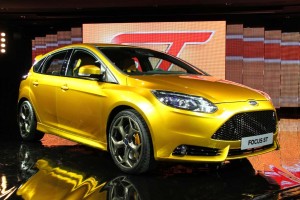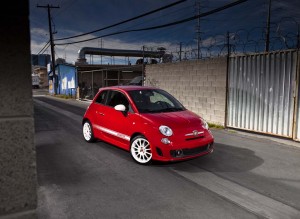Ford plans to amp up the performance of its compact Focus with the upcoming launch of the Focus ST, the sporty model making a solid 252 horsepower and 270 lb-ft of torque.
But when you need a little bit of extra power – whether off the line when the light changes or merging onto a freeway – the ST’s turbocharger packs a little surprise. Put the pedal to the metal and you’ll get a 15-second shot of adrenaline as the 2.0-liter EcoBoost engine goes into OverBoost mode.
Just like those videogames that let you punch the turbo-boost button, the inline-four engine pumps out 7.4% more torque right where you need it, between 3,000 and 4,500 RPMs.
A turbocharger harnesses a car’s exhaust gases to spin a fan that, in turn, pumps more fresh air into the engine. Most turbochargers add anywhere from 5 pounds up to a maximum twice atmospheric pressure (which is about 14 psi at sea level). But in OverBoost mode, that goes substantially higher.
Typically, makers restrain boost for several reasons. There are durability issues. But there’s also the issue of mileage, higher boost reducing a vehicle’s fuel economy.
That’s why Ford and most other makers usually limit OverBoost to, in the case of the Focus ST, a maximum 15 seconds.
“We limit peak turbo boost to maintain a wide margin of safety and durability over the life of the car,” says Lisa Schoder, Marketing Manager for the $24,995 Ford Focus ST. “But overboost is cool in that it tweaks more acceleration through the turbo for brief periods for performance-hungry drivers.”
Ford isn’t the only maker that’s adopted an OverBoost option, by the way. It’s offered on the Nissan GT-R, a variety of Mini models, such as the Mini Cooper Coupe John Cooper Works; the Fiat Abarth; and both the BMW 3-Series and Z4 sDrive35is models, as well as the Bavarian maker’s recent, limited-production 1M.
Expect to see even more performance-oriented models adopt OverBoost, in part, because more and more vehicles sold in the U.S. are opting for downsized, turbocharged engines.
Tubochargers are expected to show up on an estimated 3.2 million commercial and passenger vehicles sold in North America this year, a 1 million unit jump from 2011, according to Honeywell. General Motors, meanwhile, expects to equip 7% of the vehicles it sells in the U.S. with turbos this year – but anticipates that will jump to 10% by 2013, according to Rick Balsley, who oversees GM’s turbocharging and supercharging development.
Ford is likely to push well beyond that, however. The maker is rapidly expanding the array of cars, trucks and crossovers that can be ordered with the EcoBoost powertrain family, while also adding more versions of that engine. It will begin offering a 1.0-liter, three-cylinder version for 2013. And Ford expects to have at least one version of the EcoBoost technology available on 80% of its North American line-up by mid-decade, ranging from the subcompact Fiesta all the way up to a 6-cylinder version in the big F-150 pickup.
(Turbocharging Turbo Sales: For more on the rapid growth in turbocharging, Click Here.)


